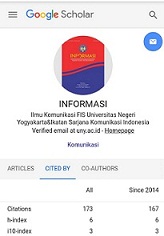A Gender-Based Communication Approach to Hasten the Prevention of Stunting in Bojonegoro Regency
Keywords:
Bojonegoro, Gender, Stunting, Communication StrategyAbstract
References
Abraham Maslow. (1954). Motivation and Personality. New York: Harper & Row.
Affifah, Tin. (2011). Perkawinan Dini Dan Dampak Status Gizi Pada Anak (Analisis Data Riskesdas 2010). Jurnal Gizi Indonesia 34(2):109-119.
Akih. (2006). Analisis Gender dan Transformasi Sosial Edisi revisi. Yogyakarta: Pustaka Pelajar.
Anne Maydan Nicotera. (2003). Understanding Organizations Through Culture and Structure. United States: Lawrence Erlbaum Associates Incorporated Publisher.
Archda, Rini and Tumangger, Jeki. (2019). Hulu-Hilir Penanggulangan Stunting di Indonesia. Journal of Political Issues 1(1).1-9
Anastasia, A., Noerdin, E., Anindhita, F., Rahayuningtyas, & Aripurnami, S. (2013). Indonesia Women's Movements: Making Democracy Gender Responsive. Jakarta: Women Research Institute .
Badan Pusat Statistik. (2022). Indonesia Pembangunan Manusia. Jakarta.
Badan Pembangunan Nasional. (2023). Tujuan Pembangunan Berkelanjutan Pilar Ke-Lima Kesetaraan Gender. Akses: https://sdgs.bappenas.go.id/tujuan-5/ 30 Agustus 2023
Bogdan, Robert C, & Sari Knopp Biklen. (1982). Qualitatif Research for Education: An Introduction to Theory and Methods (5 ed.). Boston : Allyn and Bacon Inc.
Creswell, J. (2008). Educational Research, Planning, Conducting, and Evaluating Qualitative and Quantitative Approaches (4 ed., Vol. 3). Pearson.
Daniel, M. (2003). Metode Penelitian Sosial Ekonomi. Jakarta: Bui Aksara.
Hooks, B. (2000). Feminism is for everybody: Passionate Politics (3 ed., Vol. 2). Cambridge: South End Press.
Kementrian Keuangan Republik Indonesia. (2022). Laporan Anggaran Pendapatan Daerah Se-Provinsi Jawa Timur. Jakarta.
Keputusan Bupati Bojonegoro Nomor/188/191/KEP/412.013/2022 tentang Tim Percepatan Penurunan Stunting Kabupaten Bojonegoro Tahun 2022-2024.
Kementerian Pemberdayaan Perempuan dan Perlindungan Anak (KPPPA). (2022). Pembangunan Manusia Berbasis Gender. Jakarta: Kementerian Pemberdayaan Perempuan dan Perlindungan Anak.
Kementerian Keuangan Republik Indonesia. (2022). Laporan Anggaran Pendapatan Daerah Se-Provinsi Jawa Timur. Akses: https://djpk.kemenkeu.go.id/portal/data/apbd?tahun=2022&provinsi=13&pe 30 Agustus 2023
Littlejohn, S., W. Karen A.Foss, & John G. Oetzel. (2017). Theories of Human Communication. Waveland Press Incorporated.
Kementrian Kesehatan Republik Indonesia. (2023). Laporan Hasil Survei Status Gizi Indonesia (SSGI) 2022.
Muhtar, Y. (2002). Pendidikan Berperspektif Keadilan Gender. Depdiknas.
Parsons, T., & Bales, R. (1995). Family Socialization And Interaction Process. New York: Free Press.
Pengadilan Agama Kabupaten Bojonegoro. (2023). Laporan Kinerja Pemerintah (LKP) 2023. Jakarta.
Soehartono, I. (2004). Metode Penelitian Sosial . Bandung: PT Remaja Rosdakarya.
Studi Status Gizi Indonesia. (2022). Buku Saku Hasil Studi Status Gizi Indonesia . Jakarta.
Sugiyono. (2017). Metode Penelitian Kuantitatif, Kualitatif, dan R&D. Bandung: Alfabeta CV.
Tim Nasional Percepatan Penanggulangan Kemiskinan (TNP2K). (2018). Strategi Nasional Percepatan Pencegahan Anak Kerdil (Stunting) Periode 2018-2024. Jakarta.
UNICEF. (2013). Improving Child Nutrition: The Achievable Imperative For Global. New York: United Nations Publications. New York.
World Economic Forum. (2022). The Global Riks Report 2022 17th Edition. New York.
WHO. (1996). Health Promotion Discussion Document on The Concept and Principles. Summary Report of The Working Group on Concept and Principles of Health Promotion, Copenhage
Downloads
Published
How to Cite
Issue
Section
Citation Check
License
Copyright (c) 2025 Berliananda Maranditya, Siti Andarwati, Dina Ruslanjari

This work is licensed under a Creative Commons Attribution-NonCommercial 4.0 International License.
Authors who publish with this journal agree to the following terms:
- Authors retain copyright and grant the journal right of first publication with the work simultaneously licensed under a Creative Commons Attribution License that allows others to share the work with an acknowledgement of the work's authorship and initial publication in this journal.
- Authors are able to enter into separate, additional contractual arrangements for the non-exclusive distribution of the journal's published version of the work (e.g., post it to an institutional repository or publish it in a book), with an acknowledgement of its initial publication in this journal.
- Authors are permitted and encouraged to post their work online (e.g., in institutional repositories or on their website) prior to and during the submission process, as it can lead to productive exchanges, as well as earlier and greater citation of published work (See The Effect of Open Access).











